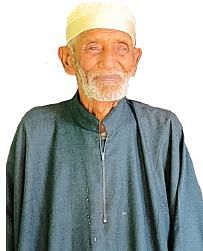Shopian: A battered stretch meandering through the thick apple orchards in south Kashmir’s Shopian town leads to idyllic Imam Sahab village.
A mini market, which has developed over the past few years, is teeming with people.
On the right side of the road, a narrow dirt lane goes straight to the single-storied house of Abdul Khaliq Bhat, a wiry nonagenarian folk artist or Bhand.
Bundled up in a woolen blanket and Pheran, Bhat talks about the glorious past of the Bhand Paether or folk theater in his village.
“It was the only and most powerful medium of storytelling and creating awareness among the masses about a host of issues,” Bhat says in a feeble voice.
He says that a blunt satire coupled with music and dance performances used to do wonders.
“Bhandhs would denounce dowry, corruption and other evils in a satirical fashion,” Bhat says.
Over 70 percent of the people in this village of well-heeled apple orchardists were associated with the Bhand Paether and the artists used to move from village-to-village to stage plays.
Bhat had an itch to perform Bhand Paether when he was young.
According to him, he was only 12-years-old when he started playing ‘Bache Kout’ (child dancer) in Bhand Paether and performed in Punjab and Lahore during the Dogra rule.
“The people outside Kashmir not only liked my performances but also loved me because of my ruby-red cheeks,” Bhat says while a smile flickers across his face.
In 1960, Bhat along with other artists of the area formed Kounsar Theater and staged hundreds of plays across the length and breadth of Kashmir under this banner.
‘Watal Paether’, ‘Bohir Paether’, ‘Darza Paether’, ‘Gosain Paether’ were some of the popular forms and plays the artists would generally stage.
In ‘Watal Paether’, the life of sweepers was showcased while ‘Bohri Paether’ would depict the life of traders and businessmen.
Similarly, the ‘Darza Paether’ portrayed the oppression and ‘Gosain Paether’ was about Shiva.
The plays used to be a heady mix of dance, music and humour.
“The artists used musical instruments like flutes and drums, and wore strange costumes and grotesque masks to amuse the people,” says Muhammad Yousuf, 70, a resident of the area who claimed to have watched a plethora of such plays.
Later, Bhat would also write and play Surnai (Kashmiri flute) in the plays.
“We used to take a dig at the corrupt officials in our plays and portrayed how they were giving a runaround to people who were reluctant to grease their palms,” Bhat says.
‘Heemal’, ‘Wazirmal’, ‘Azuk Raewaj’ were some of the prominent plays staged under the Kounsar Theater and were much appreciated by the people.
“Azuk Raewaj was a satire on the nuclear family. The ‘Maskhar’ (clown) in this play acted in such a fabulous way that he left the audience in stitches,” recalls Bhat.
Bhat says that a couplet ‘Agar bouzakh be wanie noun, Ase ha choyi nayrun baeyun’ (If you listen, I’ll tell you the truth. We have to form our own separate household) recited by the Maskhar during the play became a catchphrase.
While Bhat is the last surviving artist of the Kounsar Theatre, presently there is no artist in the village performing the Bandh Paether.
Besides Imam Sahab village, dozens of artists associated with the Bandh Paether were from Balpora, a quaint hamlet located across the gurgling Rambiara stream of the district.
“After Imam Sahab, this village was the centre of folk artists and singers,” says Ali Muhammad, a folk singer.
According to him, the folk theatre completely vanished from the district though there are still a few folk and Qawali singers in the area.
“While some theater artists have set up their own businesses, many have taken to farming and other menial jobs to scrape a living,” says Ali Muhammad, who works as a labourer for living.
The folk theater began losing its sheen in late 1980s and died down a few years ago.
The economic insecurity of the artists and the government’s indifference towards the art form are seen as the core reasons for the death of folk theater in the area.
“The artists were grappling with financial troubles and there was hardly any monetary assistance from the government which spurred them to look for other means of livelihood,” says Bhat.
Another artist, who declined to be quoted by name, says that the government never-ever made any sincere effort to preserve the folk theater, particularly in Shopian district.
“These were ordinary people who would donate paddy grains, walnuts, eggs and other commodities to the artists during the harvesting season,” he says. “The folk theatre could still be revived in the area if the government showed some interest.”







